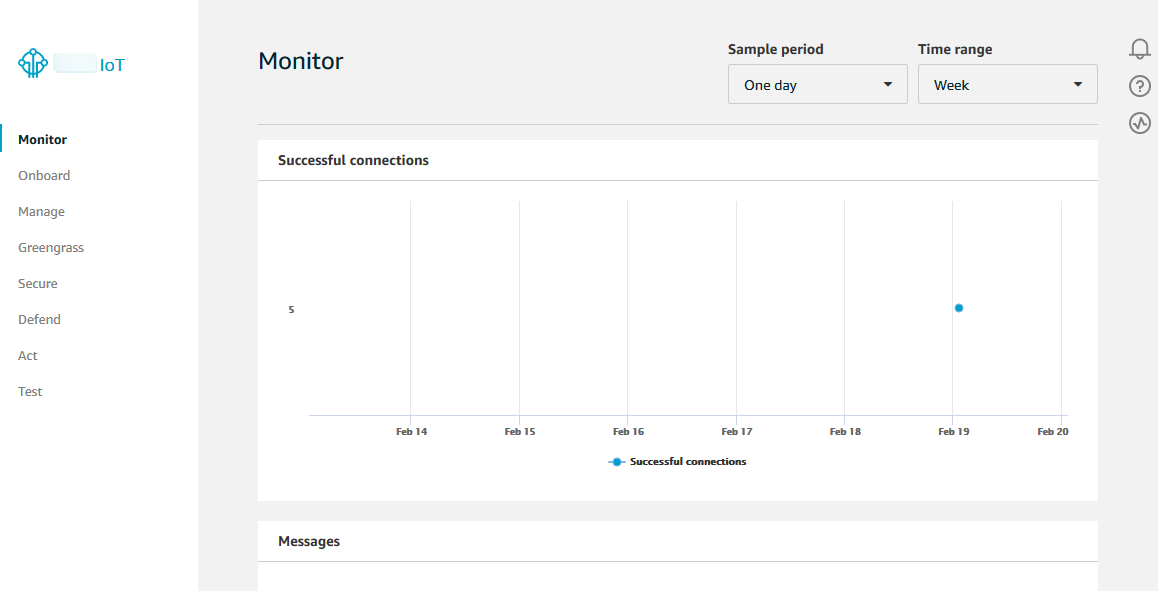终止支持通知: Amazon 将于 2025 年 12 月 15 日终止对的支持 Amazon IoT Analytics。2025 年 12 月 15 日之后,您将无法再访问 Amazon IoT Analytics 控制台或 Amazon IoT Analytics 资源。有关更多信息,请参阅Amazon IoT Analytics 终止支持。
本文属于机器翻译版本。若本译文内容与英语原文存在差异,则一律以英文原文为准。
正在将数据摄取到 Amazon IoT Analytics
如果您具有一个通道以将数据路由到管道,该管道将数据存储在数据存储以在其中对其进行查询,则可以将消息数据发送到 Amazon IoT Analytics。此处,我们介绍了两种将数据传送到 Amazon IoT Analytics的方法。您可以使用消息代理或使用 Amazon IoT Analytics
BatchPutMessage API 发送 Amazon IoT 消息。
使用 Amazon IoT 消息代理
要使用 Amazon IoT 消息代理,您需要使用规则引擎创建 Amazon IoT 规则。该规则将带有特定主题的消息路由到 Amazon IoT Analytics。但首先,该规则要求您创建一个角色以授予所需的权限。
创建 IAM 角色
要将 Amazon IoT 消息路由到 Amazon IoT Analytics 频道,您需要设置规则。但首先,您必须创建一个 IAM 角色来授予该规则向 Amazon IoT Analytics 频道发送消息数据的权限。
运行以下命令以创建角色。
aws iam create-role --role-name myAnalyticsRole --assume-role-policy-document file://arpd.json
arpd.json文件的内容应与以下内容类似。
然后,将策略文档附加到该角色。
aws iam put-role-policy --role-name myAnalyticsRole --policy-name myAnalyticsPolicy --policy-document file://pd.json
pd.json文件的内容应与以下内容类似。
创建 Amazon IoT 规则
创建一条向您的频道发送消息的 Amazon IoT 规则。
aws iot create-topic-rule --rule-name analyticsTestRule --topic-rule-payload file://rule.json
rule.json文件的内容应与以下内容类似。
{ "sql": "SELECT * FROM 'iot/test'", "ruleDisabled": false, "awsIotSqlVersion": "2016-03-23", "actions": [ { "iotAnalytics": { "channelName": "mychannel", "roleArn": "arn:aws:iam::your-account-number:role/myAnalyticsRole" } } ] }
将 iot/test 替换为应路由的消息的 MQTT 主题。将通道名称和角色替换为您在前面章节中创建的通道和角色。
将 MQTT 消息发送到 Amazon IoT Analytics
在将规则加入通道、通道加入管道以及将管道加入到数据存储之后,所有与该规则匹配的数据现在都会流 Amazon IoT Analytics 向数据存储,随时可以进行查询。要对此进行测试,您可以使用 Amazon IoT 控制台发送消息。
注意
您发送到的消息负载(数据)的字段名称。 Amazon IoT Analytics
-
必须仅包含字母数字字符和下划线 (_);不允许使用其他特殊字符。
-
必须以字母字符或单个下划线 (_) 开头。
-
不能包含连字符 (-)。
-
正则表达式术语:
^[A-Za-z_]([A-Za-z0-9]*|[A-Za-z0-9][A-Za-z0-9_]*)$。 -
长度不能超过 255 个字符
-
不区分大小写。同一负载中名为
foo和FOO的字段被视为重复字段。
例如,在消息负载中,{"temp_01": 29} 或 {"_temp_01": 29} 有效,但 {"temp-01": 29}、{"01_temp": 29} 或 {"__temp_01": 29} 无效。
-
在 Amazon IoT 控制台
的左侧导航窗格中选择 Test (测试)。 
-
在 MQTT 客户端页面上,在 Publish 部分的 Specify a topic 中,键入
iot/test。在消息负载部分,请验证以下 JSON 内容是否存在,如果不存在,则键入它们。{ "message": "Hello from the IoT console" } -
选择 Publish to topic(发布到主题)。

这会发布一条消息,该消息路由到您之前创建的数据存储。
使用 BatchPutMessage API
获取消息数据的另一种方法 Amazon IoT Analytics 是使用 BatchPutMessage API 命令。此方法不需要您设置 Amazon IoT 规则,即可将带有特定主题的消息路由到您的频道。但它确实要求将其发送 data/messages 到频道的设备能够运行使用 Amazon SDK创建的软件或能够使用调用BatchPutMessage。 Amazon CLI
-
创建一个文件
messages.json,其中包含要发送的消息(在本示例中,只发送一条消息)。[ { "messageId": "message01", "payload": "{ \"message\": \"Hello from the CLI\" }" } ] -
运行
batch-put-message命令。aws iotanalytics batch-put-message --channel-name mychannel --messages file://messages.json --cli-binary-format raw-in-base64-out如果没有错误,将显示以下输出。
{ "batchPutMessageErrorEntries": [] }